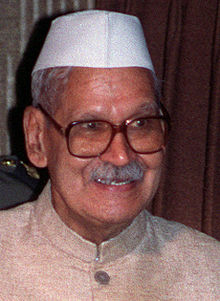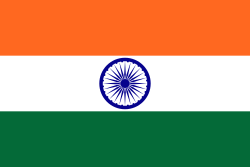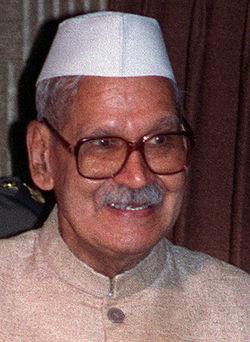Shankar Dayal Sharma
| Hans Excellence Shankar Dayal Sharma | |
|---|---|
 Shankar Dayal Sharma i 1993 | |
| Indiens 9. præsident | |
| Embedsperiode 25. juli 1992 – 25. juli 1997 | |
| Premierminister | P. V. Narasimha Rao Atal Bihari Vajpayee H. D. Deve Gowda I. K. Gujral |
| Vicepræsident | K. R. Narayanan |
| Foregående | Ramaswamy Venkataraman |
| Efterfulgt af | K. R. Narayanan |
| Indiens 8. vicepræsident | |
| Embedsperiode 3. september 1987 – 25. juli 1992 | |
| Præsident | Ramaswamy Venkataraman |
| Foregående | Ramaswamy Venkataraman |
| Efterfulgt af | K. R. Narayanan |
| Personlige detaljer | |
| Født | 19. august 1918 Bhopal, Madhya Pradesh, Indien |
| Død | 26. december 1999 (81 år) New Delhi, Delhi, Indien |
| Dødsårsag | Hjerteanfald |
| Politisk parti | Indian National Congress |
| Ægtefælle | Vimala Sharma |
| Uddannelsessted | Allahabad Universitet Universität Zürich University of Cambridge Lucknow Universitet Harvard Law School Fitzwilliam College |
| Religion | Hinduisme |
| Underskrift | |
| Informationen kan være hentet fra Wikidata. | |
Shankar Dayal Sharma (født 19. august 1918 i Bhopal, Indien, død 26. december 1999) var Indiens niende præsident. Han sad som præsident fra 1992 til 1997.[1] Før han blev valgt til præsident var han vicepræsident fra 1987 til 1992 under præsident Ramaswamy Venkataraman.
Referencer
- ^ "Former Presidents". The President of India. Hentet 15. oktober 2019.
| ||||||
| ||||||||
| Spire |
|
Medier brugt på denne side
The National Emblem of India is derived from the time of the Emperor Ashoka. The emblem is a replica of the Lion of Sarnath, near Varanasi in Uttar Pradesh. The Lion Capital was erected in the third century BC by Emperor Ashoka to mark the spot where Buddha first proclaimed his gospel of peace and emancipation to the four quarters of the universe. The national emblem is thus symbolic of contemporary India’s reaffirmation of its ancient commitment to world peace and goodwill. The four lions(one hidden from view ) – symbolising power, courage and confidence- rest on a circular abacus. The abacus is girded by four smaller animals—Guardians of the four directions: The Lion of the North, The Horse of the West, The Bull of the South and The Elephant of the East. The abacus rests on a lotus in full bloom, exemplifying the fountainhead of life and creative inspiration. The motto 'Satyameva Jayate' inscribed below the emblem in Devanagari script means 'truth alone triumphs'.
Signature of former President of India Shankar Dayal Sharma
Forfatter/Opretter: Biswarup Ganguly, Licens: CC BY-SA 3.0
Shankar Dayal Sharma, Former President of the Republic of India




